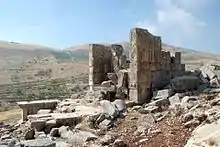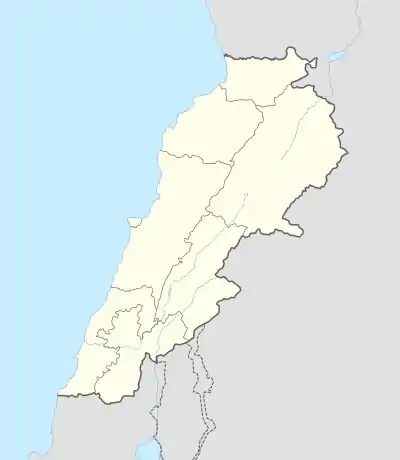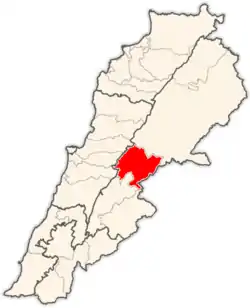Hosn Niha
Hosn Niha is an archaeological site in Lebanon composed of several temples and buildings that hold significant archaeological value. Anthropologists have predicted that the temples found at this site were previously used by a cult during the Greco-Roman period, though only limited work has been done on the site. The settlement was eventually completely abandoned. Much of the area and its buildings were destroyed during the Lebanese Civil War.[1] The site stretches across land near the Bekaa Valley for a total of 550 meters at an altitude of 1350 meters. The site is noteworthy for the numerous tombs scattered around the area. Anthropologists have discovered that there were different types of tombs, which they assumed were assigned to people based on their ranking within the culture. Due to the recent growing interest in the site, more studies have been conducted.
 Roman temple at Hosn Niha | |
 Shown within Lebanon | |
| Location | south of Dahr El Ahmar |
|---|---|
| Region | Bekaa Valley |
| Coordinates | 33°54′27″N 35°56′55″E |
| History | |
| Cultures | Roman |
| Site notes | |
| Condition | Ruins |
| Public access | Yes |
Discovery
The earliest written mentions of the site come from European travelers in the nineteenth century. Recently, Jean Yasmine conducted detailed studies of the sanctuary and its architecture. Yasmine's work focused on mapping the sanctuary's layout. He was able to identify residences found within the village. He used different methods of research, such as surveying at landscape and built-up archaeology levels. His findings included the discovery of different tombs placed across the site and the important building nicknamed "La La Grande Residence." This building contained many valuable pottery artifacts that helped archaeologists develop further research and hypotheses about the culture's values and beliefs.[2]
Geography
The Hosn Niha site was discovered near the Beqaa Valley and lies at the base of a steep slope.[3] It is surrounded by large agricultural fields that are still being used today. Archaeologists discovered a sanctuary with two temples inside, with one being larger than the other. This sanctuary also contains a church and several cult rooms. A smaller sanctuary and two big quarries were also found further down. An ancient trade route was discovered along the valley, running from the east towards Niha, another archaeological site found nearby.[4]
Location
Because of the site's location and steep slope, the village is sheltered while still receiving a large amount of sunlight. A river that flows through the village once provided the inhabitants with a sufficient water source. Anthropologists also discovered a spring not too far from the sanctuary.
The site has some drawbacks. Since it is at such a high altitude, the winters can be very harsh. Winters reach extremely low temperatures and produce large snowfalls. The snow may have had a particularly large impact on the village's survival because it could block trade routes coming from and going to the sanctuary complex.
Findings
Pottery
Disturbances created from outside forces brought sherds of pottery to the surface. These pieces of pottery were an incredible finding because they gave archaeologists better insight about the people who once inhabited the area. After studying the fragments, Yasmine was able to determine that they were created in the first century AD and held extreme value to the culture, until the site was abandoned in the seventh century AD.[5] These pottery sherds helped archaeologists strengthen their assumptions of their existence during the Greco-Roman era.
Tombs
Before becoming an active archaeological site, the tombs had been targeted by looters for items of value that were buried with their owners. In addition to a nearby cemetery, excavators found a variety of tombs, including communal tombs, individual cast tombs, and stone sarcophagi. Rock-cut tombs were the more common type found at the site. Interestingly, many of these tombs had entryways built into them. These entryways were usually created for people to place their offerings to the dead.
Cist tombs usually include multiple tombs arranged closely together. This layout led excavators to believe that these people were buried near each other because they were within the same family.[6]
Sanctuaries
The double sanctuary was also an important structure to the site. This sanctuary consisted of several dormitory rooms and rooms that were specifically meant for sacrifices and rituals. Many of the altars found within these rooms have symbols of bulls' heads and garlands, which supports the hypothesis that this culture practiced sacrificial rituals. Larger rooms with larger altars are speculated to be a "male god's" room. The smaller attached room was usually assigned to the god's companion or partner.[7]
References
- Newson, Paul; Young, Ruth (2015/04). "The archaeology of conflict-damaged sites: Hosn Niha in the Biqaʾ Valley, Lebanon". Antiquity. 89 (344): 449–463. doi:10.15184/aqy.2015.4. ISSN0003-598X.
- Newson, Young, Paul, Ruth (2011). "Archaeological assessment of the site at Hosn Niha Preliminary report 2011-2012": 257–280 – via Anth 3SS instructor.
- Newson, Paul; Young, Ruth (2015/04). "The archaeology of conflict-damaged sites: Hosn Niha in the Biqaʾ Valley, Lebanon". Antiquity. 89 (344): 449–463. doi:10.15184/aqy.2015.4. ISSN0003-598X.
- Yasmine, Jean (2013). "The Niha Sites (Lebanon) cultural landscape: A 3D model of sanctuaries and their context". International Archives of the Photogrammetry, Remote Sensing and Spatial Information Sciences. XL-5/W2.
- Newson, P., & Young, R. (2015). The archaeology of conflict-damaged sites: Hosn Niha in the Biqaʾ Valley, Lebanon. Antiquity, 89(344), 449-463. doi:10.15184/aqy.2015.4
- Newson, Young, Paul, Ruth (2011). "Archaeological assessment of the site at Hosn Niha Preliminary report 2011-2012": 257–280 – via Anth 3SS instructor.
- Newson, Young, Paul, Ruth (2011). "Archaeological assessment of the site at Hosn Niha Preliminary report 2011-2012": 257–280 – via Anth 3SS instructor.

